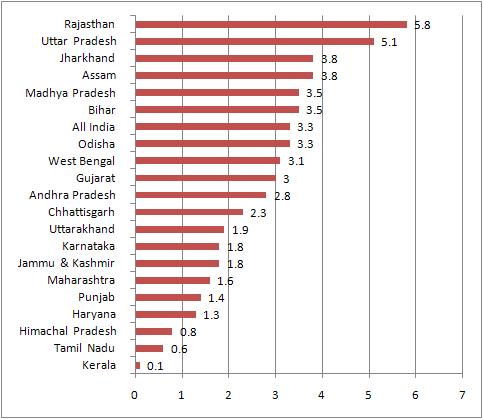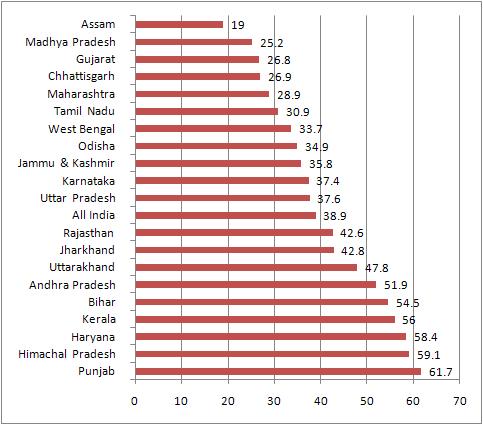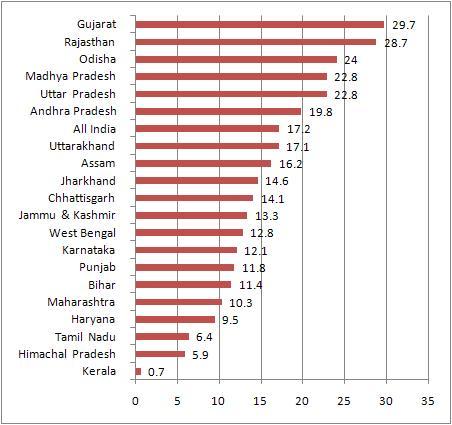Gujarat’s much tom-tommed girl child enrolment drive, nick-named as Kanya Kelavni, appears to have gone down the drain, and there appears very little for the state government to cheer over its campaign, which began in 2004 as Mahotsav or festival, if the latest Annual Status of Education Report (ASER), 2013, released by well-known advocacy group, Pratham, is any indication. The report not only suggests that as many as three per cent of the state’s children in the age-group 6-14 are “out of school” – a criterion worked out in order to combine the children who are school dropouts and those who were never enrolled in schools. It also suggests that the three per cent “out of school” figure of Gujarat is worse than 11 other Indian states.
Worse – and this should make the state policy makers think up as to what may have gone wrong with Kanya Kelavani – the ASER survey has found that an increasing number of girls were “out of school” as they moved to higher classes.
- The ASER survey’s findings – which concentrate their attention on rural India further suggest that in the age-group 7-10, as many as 1.5 per cent of Gujarat girls were out of school, as against 0.9 per cent boys. This was higher than as many as 11 other states – Kerala (zero per cent), Chhattisgarh (1.4 per cent), Haryana (0.3 per cent), Himachal Pradesh (0.3 per cent), Karnataka (0.7 per cent), Maharashtra (0.8 per cent), Punjab (0.8 per cent), Tamil Nadu (0.1 per cent), Uttarakhand (0.7 per cent), West Bengal (0.5 per cent), and Andhra Pradesh (1.0 per cent) – and equal to two states, Assam and Jammu & Kashmir. And this is the worrying trend it found: Gujarat’s ranking slipped very badly in the two higher age-groups identified for “out of school” girls – 11-14 and 15-16.
 |
| Out of school children (age group 6-14) |
Thus, in the age-group 11-14, as many as 6.6 per cent of the girls were found to be “out of school” in Gujarat, as against 3.7 per cent boys. This, the ASER survey shows, is higher than not just progressive states but also such states whose human development index has been traditionally very weak. Thus, the percentage of out of school girls in this age group in Bihar was found to be 4.6, of Chhattisgarh 3.8 per cent, of Haryana 3.1 per cent, of Himachal Pradesh 1.0 per cent, of Jammu & Kashmir 3.5 per cent, of Jharkhand 5.2 per cent, of Karnataka 3.0 per cent, of Kerala zero per cent, of Punjab 2.1 per cent, of Madhya Pradesh 5.9 per cent, of Maharashtra 2.5 per cent, of Odisha 5.3 per cent, of Tamil Nadu 0.7 per cent, of Uttarakhand 3.8 per cent, of West Bengal 4.0 per cent, of Andhra Pradesh 5.7 per cent and of Assam 5.4 per cent.
 |
| Percent children of standard VI-VIII who can do division |
Notably, the ASER survey found that just two states out of the 20 big ones performed worse than Gujarat in the “out of school” category of the age group 11-14. These are Uttar Pradesh, whose 9.4 per cent girls were “out of school”, and Rajasthan (12.1 per cent). Indeed a worrying trend for the managers of Gujarat’s Kanya Kelavni drive: The national average of “out of school” girls in the age group 7-10 was better than Gujarat’s (1.5 per cent compared to the all-India’s 2.1 per cent), but seemed to go out of hand in the age group 11-14. In the latter age-group, Gujarat’s 6.6 per cent girls were found to be out of school, as against the all-India figure of 5.5 per cent.
 |
| Percent children of standard III-V who can do subtraction or more |
Coming to the age-group 15-16, when children go in for higher secondary education, ASER found, Gujarat has the highest percentage of “out of school” girls compared to any other state of India. The figures collected by it suggest that as many as 29.9 per cent of Gujarat’s girls were out of school, as against the national average of 17.2 per cent! All so-called backward states outperform Gujarat. The state that comes nearest to Gujarat in sending fewer girls than other Indian states to the higher secondary is the neighbouring Rajasthan, with 28.9 per cent out of school girls. One has only to see how other backward states have outperformed Gujarat in sending their girls to higher secondary schools – Bihar has 11.4 per cent “out of school” girls in the age-group 15-16, Chhattisgarh 14.1 per cent, Uttar Pradesh and Madhya Pradesh 22.8 per cent each, Odisha 24 per cent, and Assam 14.6 per cent.
 |
| Percent children of standard VI-VIII) who can read class II level text |
The ASER survey, which focuses on finding out how the quality of education in India is doing, also suggests that the Gujarat government’s quality education drive, named “Gunotsav”, too, has failed to make any impact on the children. Thus, Gujarat’s 67.8 per cent of the children of standards VI to VIII could read standard II class textbooks. The states whose children were found to have done better than Gujarat include Kerala 87.9 per cent, Himachal Pradesh 86.7 per cent, Punjab 82 per cent, Haryana 78.9 per cent, Uttarakhand 76.2 per cent, Maharashtra 72.5 per cent, Chhattisgarh and Andhra Pradesh both 72.3 per cent, and Rajasthan 70.1 per cent. The national average for the children of VI-VIII standards, who could read standard II textbooks, was slightly better than Gujarat’s, at 65.7 per cent.
However, in simple arithmetic, the ASER survey found, Gujarat’s performance was one of the worst. Thus, Gujarat’s 26.8 per cent children studying in classes V-VIII were found to be capable of doing simple division sums. This was worse than all other states, except two – Assam (19 per cent) and Madhya Pradesh (25.2 per cent). Similarly, as many as 32.2 per cent Gujarat children studying in standards III-V could carry out subtraction sums successfully, with only four out of 20 major states performing worse than Gujarat – Madhya Pradesh 22.3 per cent, Chhattisgarh 27.7 per cent, Assam 30.1 per cent and Maharashtra 31.7 per cent.
Released on January 15, the ASER, while favouring strict implementation of the Right to Education (RTE) law, believes that things should be left in private hands to ensure that the RTE is properly followed! Its CEO Madhav Chavan believes that state governments must encourage private schools instead of “curtailing them”. Saying that any effort to curb private schools “is no more a democratic option unless a visibly better government school alternative can be presented”, he adds, “By introducing 25% reservation for economically weaker sections, the Right to Education Act has in fact opened the door for unaided schools being aided by the government. There is no reason why government-aided and privately managed schools cannot be encouraged further.”


Exiled at Home
ReplyDeleteStory of Sikh farmers in the Kutch District of Gujarat who were brought into the area after the 1965 war but were denied land rights by the state government after the land prices went up in the area.
http://www.youtube.com/watch?v=18uFQZleGhQ
Feku Gang
ReplyDeletePresenting you the #Feku Gang who have all the qualities to set the nation to a downfall when they get together... Watch, Enjoy & Share!
http://www.youtube.com/watch?v=QUUhoifo5vU